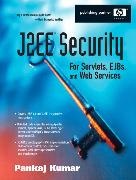Condividi
Fr. 55.90
Pankaj Kumar
J2EE Security for Servlets, EJB's, and Web Services
Inglese · Tascabile
Spedizione di solito entro 3 a 5 settimane
Descrizione
Applied security techniques for J2EE programmers and developers, written by a security expert at Hewlett Packard.
Explains security concepts in simple terms and relates these to standards, Java APIs, software products and day-to-day job activities of programmers.
Written by a practitioner who participated in the development of a J2EE App Server and Web Services Platform at HP.
Applied security measures demonstrated on Java APIs - a unique feature of the book. Dealing with security issues continues to be challenging for programmers and developers. In this book, expert practitioner Pankaj Kumar walks through both the descriptions and resolutions of those security issues that Java professionals will run into while designing, building, deploying and operating solutions that use J2EE technologies - such as Servlets, EJBs and Web Services. Unlike most books on security, Kumar covers security concepts such as authentication, authorization, confidentiality, integrity and non-repudiation in the context of security standards, Java APIs and software products implementing these technologies, while demonstrating how to use these in creating solutions.
Pankaj Kumar is a software architect at the Middleware Division of Hewlett-Packard Co. He participated in the development of a J2EE App Server and Web Services Platform, and maintained the overall performance, security, standards compliance, consistency and usability of middleware products. He also represented HP in two important Java Community Process (JCP) Expert Groups developing Java Web Services standards: JAX-RPC and JSR109. He has more than 14 years of industry experience includes working as a programmer, development manager and architect in a wide variety of middleware technologies and enterprise solution projects in Java and C/C++.
Sommario
I. THE BACKGROUND.
1. A Security Primer.
The Security Problem. Computers, Networks and the Internet. Security Concepts. Security Attacks. System Vulnerabilities. Toward the Solution. Summary. Further Reading.
2. A Quick Tour of the Java Platform.
Packaging of Java Platform. Evolution of Java. Java Security Model. J2SE Platform. J2EE Platform. Summary. Further Reading.
II. THE TECHNOLOGY.
3. Cryptography with Java.
Example Programs and crypttool. Cryptographic Services and Providers. Cryptographic Keys. Encryption and Decryption. Message Digest. Message Authentication Code. Digital Signature. Key Agreement. Summary of Cryptographic Operations. Cryptography with crypttool. Limited versus Unlimited Cryptography. Performance of Cryptographic Operations. Practical Applications. Legal Issues with Cryptography. Summary. Further Reading.
4. PKI with Java.
Digital Certificates. Managing Certificates. Certification Authority. PKI Architectures. Java API for PKI. Applications of PKI. PKI Use-Cases. Summary. Further Reading.
5. Access Control.
A Quick Tour of Java Access Control Features. Access Control Requirements for the Java Platform. User Identification and Authentication. Policy-Based Authorization. Developing a Login Module. Applying JASS to a Sample Application. Performance Issues. Summary. Further Reading.
6. Securing the Wire.
Brief Overview of SSL. Java API for SSL. KeyManager and TrustManager APIs. Understanding SSL Protocol. HTTP over SSL. RMI Over SSL. Performance Issues. Trouble Shooting. Summary. Further Reading.
7. Securing the Message.
Message Security Standards. A Brief Note on Handling XML. XML Signature. Java API for XML Signature. XML Encryption. Java API for XML Encryption. XML Signature and Encryption Combinations. Summary. Further Reading.
III. THE APPLICATION.
8. RMI Security.
Sample Application Using RMI. Security from Downloaded Code. SSL for Transport Security. RMI and Access Control. Summary. Further Reading.
9. Web Application Security.
Java Web Applications. Apache Tomcat. A Simple Web Application: RMB. Security Requirements. User Authentication Schemes. Web Container Security Features. HTTPS with Apache Tomcat. Common Vulnerabilities. Summary. Further Reading.
10. EJB Security.
A Brief Overview of EJBs. Working with WebLogic Server 7.0. EJB Security Mechanisms. Declarative Security for EJBs. Declarative Security Example. EJB Security and J2SE Access Control. Summary. Further Reading.
11. Web Service Security.
Web Services Standards. Web Services In Java. Apache Axis. Servlet Security for Web Services. SSL Security for Web Services. WS Security. WS Security with Apache Axis. Summary. Further Reading.
12. Conclusions.
Technology Stack. Authentication and Authorization. Distributed Application Security. Comprehensive Security.
Appendix A: Public Key Cryptography Standards.
Appendix B: Standard Names-Java Cryptographic Services.
Appendix C: JSTK Tools.
Appendix D: Example Programs.
Appendix E: Products Used For Examples.
Appendix F: Standardization Bodies.
References.
Index.
Info autore
PANKAJ KUMAR is Software Architect at Hewlett-Packard's Web Services Management Organization and has worked extensively in the area of middleware and security. He has presented on Java and Web services technologies at events ranging from SD West and SD Forum to HP World.
Riassunto
This guide provides applied security techniques for J2EE programmers and developers. It explains security concepts in simple terms and relates these to standards, Java APIs, software products and day-to-day job activities of programmers.
Dettagli sul prodotto
| Autori | Pankaj Kumar |
| Editore | Pearson Education |
| Lingue | Inglese |
| Formato | Tascabile |
| Pubblicazione | 01.01.2003 |
| EAN | 9780131402645 |
| ISBN | 978-0-13-140264-5 |
| Pagine | 464 |
| Dimensioni | 177 mm x 234 mm x 27 mm |
| Peso | 890 g |
| Serie |
Prentice Hall Prentice Hall |
| Categoria |
Scienze naturali, medicina, informatica, tecnica
> Informatica, EDP
> Internet
|
Recensioni dei clienti
Per questo articolo non c'è ancora nessuna recensione. Scrivi la prima recensione e aiuta gli altri utenti a scegliere.
Scrivi una recensione
Top o flop? Scrivi la tua recensione.

